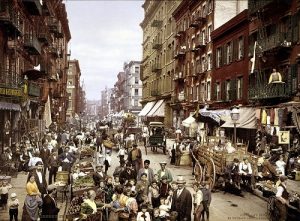Yesterday I visited another world. I’d come out of nearly 100 degree heat in Vineland, New Jersey into the nicely air conditioned office of Jane Detweiler, the Executive Director of Elwyn New Jersey, one of the foremost sites for work with intellectual disabilities. I was there because of the facility’s past as the Vineland School for Feebleminded Children, one of the settings for my novel in progress.
“Feebleminded? How archaic!” I imagine you saying, and you would be right. Much has changed since the early days of intelligence testing in the United States, when it was essentially a pseudoscience designed to make the case for the natural superiority of affluent white males, and a means of getting the upper hand on what was seen as the menace of low intellect to the American gene pool. Henry Herbert Goddard, the director of research at Vineland in the early 1900s, advocated institutionalizing the “feebleminded” in colonies like Vineland, to give them the opportunity for a dignified and productive life and of equal importance, to take away the opportunity to “breed” future generations.
Here I was, at “ground zero” of the eugenics movement in early twentieth century America. I’d come for little more than to get a few details to add color to my novel and fix anything I had imagined incorrectly. Now, however, I was hearing the words that historians and historical novelists may wait in vain to hear once in their entire careers: “There are a lot of boxes of files upstairs. Would you like to take a look?”
“It’s not air conditioned on the top floor, and the books and files were just dumped there when Goddard’s laboratory building was torn down,” Jane Detweiler explained. She wasn’t kidding. It was brutally hot, worse than outdoors for lack of any breeze. Dozens of boxes, many with their contents littered on the floor, filled several rooms that had once served as dormitories for some of the residents. In one, a rotting wooden file cabinet held decrepit drawers, full of hundreds of file folders, each containing the records of a young person living at Vineland in the early twentieth century.
Faces of those who might have lived in that very room looked out at me from photographs. Lives of the long-dead pieced themselves together before me. A world that had been vibrant and real only in my mind was literally in my hands.
Intakes at admission were done in the neat hand of an era when penmanship mattered and spelling not so much. Checklists of possible characteristics, like “sullen,” “whiny,” or “cheerful,” were marked. Test results, and even raw data like the pencil tracks made by a patient trying to complete a maze, were in the file. Quarterly reports revealed whether they made their bed neatly, dressed and bathed themselves, ate well, got along with others, and remembered what they had been told. Because Goddard believed that weak intellect and poor morals went hand in hand, the reports were full of value judgments about the character of these children. Diseases and conditions such as tuberculosis, epilepsy, and left-handedness were all treated as corroborating signs of degeneracy.
In another box, I found tools used for the tests–puzzles matching wooden shapes of stars and squares to the outline of the shape on a piece of paper; cards with keys, dogs, and other objects used for identification and sentence-generation exercises; and cubes with different patterns of dots used for matching.
Elsewhere, I found a field notebook of visits to the families of children living there, containing information about the presumed mental capacities of family members, including guesses about the “moron” status of people dead or disappeared, based on anecdotes. Again the snap judgments about the morality and intellect of these human beings made me wince.
Sweat-drenched, I left when everyone was preparing to close up for the day. I sat in the car for a moment pondering the fact that there is no money to do anything with these files. They’re brittle and crumbling from exposure to heat and constant light, and will be lost unless someone sees the value of a funding a project to preserve them.
I had one more stop, the Vineland School’s cemetery. On rows of markers so small the weeds nearly obliterated them, I saw the names of the dead. Experts now suggest that some of those lying underneath my feet spent their life at Vineland as a result of a misdiagnosis of a learning disability rather than any real retardation. Goddard himself lived long enough to recant many of his views about the prevalence and problems of “morons” in American society, and Vineland changed over the years to accommodate– and pioneer–better diagnostics and treatment plans.
How do we weigh the freedom these children lost by being confined at Vineland? Were the people whose files I read better off there even if they were misdiagnosed? Many of them were from destitute families living in total desperation, children whose lives improved immeasurably when they came to Vineland. How do we evaluate the tradeoff of enforced childlessness in exchange for opportunities to live a peaceful, more interesting, and higher functioning life? Was it a “Village of Happiness,” as Goddard liked to call it? I’d like to think so, but in a culture that values freedom above all else, it’s more than a little difficult not to squirm.



